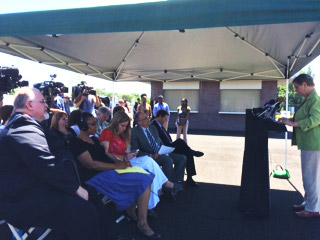Field Trip to Camden, NJ
By Carsen Mata
My walk to the office on Monday morning was quite different compared to most days. My stride longer, my pace faster, today I was going on a field trip! This wasn’t just any old field trip by the way, this was a two-hour trek from New York City down to Camden, New Jersey. The field trip crew that I accompanied consisted of a few seasoned EPA Region 2 staff members, our Regional Administrator Judith Enck, and Congressman Norcross of District One. The day’s itinerary had us hopping from one event to the next, guaranteeing an eventful day. First up – the Puchack Well Field site in Pennsauken, NJ. Upon arrival we were greeted by John Gorin, the remedial project manager for the site. John is the go-to guy for all things Puchack, especially when it comes to the ins and outs of the cleanup process.
The coolest part of the morning was seeing the site in full operation mode. This was surely the perfect time for a visit. Cranes and sifters were at work, soil from one area was being transported to another, and misters above the site gates were spraying the perimeter of the work zone. When everyone arrived John ran us through a brief overview of the work being done and the potential action items to come. After a short announcement and photo-op for the press we headed over to the next event at the Ray and Joan Kroc Salvation Army Center in Camden.
It was here that we met the Director of Economic Development for Camden, Jim Harveson, who excitedly joined Judith and Congressman Norcross in announcing that the Camden Brownfields program was receiving nearly $1 million in EPA grants. This package of grants will go towards the cleanup efforts at sites in Camden like the Harrison Avenue landfill and the former warehouse, experimental lab, and toy assembly plant at East State Street.
The press event was held outdoors with the recently constructed ball fields and playground of the Salvation Army Center serving as a beautiful backdrop. All of the event’s speakers were wonderful but Congressman Norcross, a Camden native, stepped up to the podium to address the media with a sentimental message. He reminisced about what this space once looked like and what the development of sites like these meant to the people that live there. It is clear that these grants represent much more than funding for various development projects. They symbolize the perseverance of a community that has been burdened by decades of industrial pollution. After many trying years, this area and its residents are on their way to environmental and economic success, something every community deserves.
Jim Harveson concluded the event by inviting everyone that attended back in two years. By then, he hopes the site will feature a waterfront park as well as a field of solar panels to power the center. For now, they’re taking it one site at a time, making every grant dollar count.
To finish off our day we visited a portion of the Welsbach & General Gas Mantle Superfund site in Gloucester City, just fifteen minutes south of Camden. Although a great deal of the cleanup work has already been completed, this particular area has soil and building surfaces that are still contaminated by radioactive waste. It is also situated on one of the busiest port facilities in the region, making it uniquely complex for all parties involved in the cleanup. We were joined by Rick Robinson, the remedial project manager of the site and Leo Holt – president of Holt Logistics, the owner and operator of the port, for a short bus tour around the property.
As soon as we witnessed cleanup and port activity occurring simultaneously, we understood the complexities of the site on a deeper level. Humongous containers filled with fruits and vegetables from all over the world were being transported by even bigger pieces of construction machinery. On the other side of the property EPA cleanup activities were being completed. I suddenly wondered, “all this activity AND an EPA cleanup? At the same time?” I’ve never felt so small in my life! Seeing the port in action and learning about the cleanup from such experienced staff solidified the fact that the EPA will stop at nothing to protect human health and the environment!
I think it’s safe to say this might be one of the best field trips I’ve ever been on.
About the Author: Carsen Mata is an intern for the EPA Region 2 Public Affairs Division. She currently resides in Jersey City, NJ and is a graduate of Fairfield University in Fairfield, CT. She is entering her last semester of graduate school at Fairfield University and will be receiving her Master of Public Administration in December 2015.



